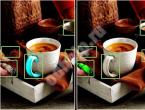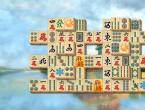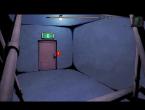Large domino made of handmade wood. Lotto and dominoes
- do it yourself? Easily! You can always make dominoes at home, quickly and most importantly, simply. What you need for this: a high-quality template in pdf, just one a4 sheet, a loose sheet of white cardboard and a regular black and white printer. Making a homemade domino set is very easy. The main thing is that you have 15-20 minutes of free time. So, how to make dominoes with your own hands out of paper.
Printing out the template
The first thing to do is print the template. I offer a pdf file. You don't need to edit anything. Just click on "print". If necessary, you can edit the template in a photo editor.
Download and print paper dominoes:
There are 28 bones in the set. All of them fit on one sheet of a4. A word of advice: since paper dominoes do not last long, it is better to print 3-4 sheets at once. Paper templates need to be glued onto pre-prepared cardboard templates. I'm using loose, plain cardboard. Bone size: 25 x 50 mm.
You have probably seen giant chess that you can play in the park or in the country. So you can combine mental and physical activity. But it is very difficult to make such chess with your own hands, but you can make a huge domino without any problems. This is exactly what we propose to do.
Materials and tools for making dominoes:
- fairly wide boards (depending on how big the dominoes you want to make)
- dark stain
- White paint
- paint brush
- a circular saw
- grinder
How to make dominoes
Prepare the required number of boards. The length of each domino must be twice the width of the board. There should be 28 such bones.
Saw the boards into equal rectangles. Sand all edges with a grinder.

Treat the boards with stain. If they are not dark enough, the stain can be reapplied. Let the stain dry.

After drawing a strip of white paint, divide each bone into two halves.

Mark the bones:
- two zeros and then 0/1 to 0/6
- two units and then 1/2 to 1/6
- two deuces, and then from 2/3 to 2/6
- two threes and then 3/4 to 3/6
- two fours and then 4/5 and 4/6
- two fives and 5/6
- two sixes.

Let the paint dry. Giant domino bones are ready. You can go outside and play with friends.

Original article in English.
Today we will deal with difficult wood crafts, of course they are for men. I will tell you how to make dominoes out of wood with your own hands of huge size. This handmade domino will decorate your garden and give it exclusivity, so you can really enjoy this game in nature. We will not need a lot of material, and if you have some experience, then it will not take much time to make.
To create a wooden domino we need:
1. Wide and thick board;
2. Automatic circular saw;
3. Apparatus for grinding;
4. Mordant;
5. Special brush;
6. White paint.
You need to figure out the length of one piece. Measure the width and double the length. So we need 28 .

Here's what should happen in the initial version. And there are 28 of them in total.

We make all the blanks at once, store them together to measure the size. Of course there will be small discrepancies, but it does not matter.

We process workpieces with a grinding machine. Then we lubricate the stain and leave to dry and so on several times.

Now we will draw sticks and dots on the domino bones. Divide in half with white paint and apply the values.

This is how you need to distribute the values on the boards:
1. two zeros, and then from 0\1 to 0\6;
2. two units, and then from 1/2 to 1/6;
3. two deuces, and then from 2/3 to 2/6;
4. two triples, and then from 3/4 to 3/6;
5. two fours, and then 4\5 and 4\6;
6. two fives and 5/6;
7. two sixes.

We leave the paint to dry and after a while you can already play on the grass.
Tov. Alexey Mokeev sent me a whole story about how he made a copy of the game himself Triomino. To do this, he needed modeling paste, an aluminum can, stationery, and some effort. And here's what came out of it all.
Story
Recently, friends had a chance to play a board toy - a triangular domino (Trimino, Triominos).
Short Description:
At the three vertices of each knuckle there are numbers from 0 to 6. There are 56 knuckles in total, since not all possible knuckles are present in the set, but only such that the numbers on the vertices go clockwise in non-decreasing order, if you start with the smallest value (or one of the smallest values). Two (or even one) or more people can play.
I really liked the game, and I decided to get my own copy. But here two snags arose: firstly, in Samara, neither in specialized game stores, nor in any bookstores there, this game is available, and secondly, in Moscow online stores it costs from 890 rubles. and with a pre-order for 3 months in advance, which, of course, did not suit me. In this connection, I decided to make the game myself.
Process
To make it I needed:
- paste for modeling (124 rubles per 500 gr.);
- aluminum can from under any drink (23 rubles);
- ruler (in my case, a tape measure);
- stationery knife or scissors;
- pen, paper, sharp cone-shaped object (in my case, an ordinary brush for drawing);
- several plastic bags, a rolling pin (or a cylindrical bottle);
- adhesive tape, plastic card (or any other hard material, cardboard for example);
- skin (or needle file, file, etc.).
Mat. part: There are 56 "triminoes" in a tromino. Each of them is marked with three numbers from "0 0 0" to "5 5 5" without repetition.
Here is a complete list of all Triminos: 000, 001, 002, 003, 004, 005, 011, 012, 013, 014, 015, 022, 023, 024, 025, 033, 034, 035, 044, 045, 055, 111, 112, 113, 114, 115, 122, 123, 124, 125, 133, 134, 135, 144, 145, 155, 222, 223, 224, 225, 233, 234, 235, 244, 245, 2 55, 333, 334, 335, 344, 345, 355, 444, 445, 455, 555.
Those. in the end, all the work comes down to making 56 isosceles triangles with numbers printed on them in the right order.
As a material for making triminos, I chose modeling paste:
There are several reasons: firstly, it is easy to work with paste (as far as I knew, I had never come across it before), and secondly, options from flat materials (isolon, for example, about which) are not suitable, because. triminos should stand vertically in front of the players, thirdly, this is a fairly cheap material. There was, of course, an idea to make them out of wood, but it would be very expensive and difficult, although perhaps more aesthetically pleasing.
First of all, I wrote out all the combinations of triminos on paper, so that later I wouldn’t get confused when drawing numbers on triminos (the photo will be later).
Next, I had to choose the desired size of my tromino. Having cut out several options from paper, I settled on a rib length of 35 mm - it will be convenient to apply numbers on such a triangle, and it will not be bulky. After choosing the size, I started making a "shape" for cutting triangles out of the paste.
I made a shape from a cut aluminum can:
- cut off the top and bottom, leveled from the folds;
- with a knife I lined one edge (which will be the "cutter");
- cut a strip 35 mm wide from a plastic card;
- around this strip bent aluminum three times, cut off the excess;
- I wrapped the resulting form with tape so that it would not fall apart.
Upper line - cuts off the excess (56 triangles do not completely fill the outer triangle with an edge of 280 mm).
After that, with the help of a bottle, I rolled out the entire piece of pasta to fill the drawn trapezoid. From the first time, it was not possible to roll out either the desired shape or uniform thickness, I did it 2-3 times, since the pasta is easily crushed and rolled out again. Here, unfortunately, there is no photo, because. I was in a hurry so that the paste would not freeze, and I was afraid to stain the phone on which I took the photo. It should be noted that at room temperature the paste keeps quite soft for 2-3 hours, although while I cut it into a trimino shape and then put numbers on them, I tried to keep the parts of the paste that were not currently used covered with polyethylene.
After about 1.5 hours, this is what happened - 56 almost isosceles triangles:
Further, using a pre-prepared cheat sheet with combinations, I applied the reverse side of the brush (the one without lint) to the triminos all the combinations. It took me about 2 hours, because. in addition to drawing numbers, I evened the edges of the triminoes a little more so that they would look more like isosceles triangles, and also watched the reverse side of the triminos so that there were no "noticeable" defects on it, by which they could be remembered. Because the paste was still soft - and the shape of the ribs and surface defects were easily corrected by smearing with a finger. Here's what happened at the end:
In this form, the triminos remained to rest for 24 hours (as it is written on the packaging of the paste):
(It looks yellow in the photo, but it's actually a light grey).
24 hours, of course, I did not wait. In the morning (after 10 hours) the paste was already warm and hard. You can proceed to the next step - smoothing the edges of the trimino with a sandpaper (or needle file).
This part of the work turned out to be the dirtiest - the dust was everywhere ... The task of alignment was that the trimino would stand on all 3 faces. The photo shows that all triminos were placed vertically, and only 2 or 3 stood up only on 2 sides, the rest - on all 3.
In general, this is where the main work ends. Next, it is supposed to paint the numbers on the triminoes in different colors and, possibly, cover them with a glossy varnish for beauty. But that's next time. At the end - a photograph of a tromino folded according to the rules:
Only the top two triminos I did not find where to put them.
As a result, I am pleased with the result. Of course, I didn’t succeed in 56 absolutely identical and even triminos, but I didn’t set myself such a task, because, firstly, I was limited in time, and, secondly, I worked with such a paste for the first time (yes and in general with pasta), and, to be honest, I was not at all sure that at least something would work out. But it worked!
Thank you for your attention.
Similar posts





